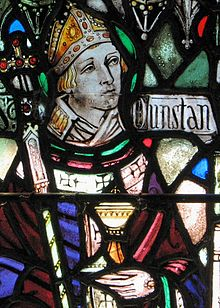St Dunstan

Benedictine monk and reformer, Archbishop of Canterbury. Patron of goldsmiths, jewellers and locksmiths. Born in 909 at Baltonsborough, near Glastonbury, Dunstan was educated at Glastonbury and then after a spell of working for his uncle, joined the court of King Athelstan. In 935 he was expelled for studying pagan poetry and being a musician.
For a time he considered marriage, but eventually decided to become a priest. He lived for a while as a hermit, doing metalwork and painting. In 939, Edmund became king of Wessex and installed him as abbot of Glastonbury.
Monastic life in England had virtually died during the Danish invasions, but under his rule it was reborn and would thrive until the Reformation. Dunstan refounded many abbeys including Malmesbury, Westminster, Bath and Exeter.
In 970 a conference of bishops, abbots and abbesses drew up a national code of monastic observance based on the Rule of St Benedict. St Dunstan was principle advisor to all the Wessex kings of his time.
During the reign of the youthful Edwy, he was banished abroad. Edgar recalled him and in 959 he was made Archbishop of Canterbury. The present coronation rite derives from the one complied and used by St Dunstan for King Edgar. Besides his pastoral ministry, his monastic organisation and reform of church life, St Dunstan had many other gifts. He was an accomplished metalworker and bellfounder. He played the harp and loved to sing. When he sang at Mass, a contemporary wrote: "He seemed to be talking with the Lord face to face."
As an old man he took delight in teaching the boys at the cathedral school. He was described as a gentle teacher, much loved by his pupils. His emblem in art is a pair of tongs - which he used, according to legend to seize the nose of the Devil.
On Ascension Day in 988, he preached three times. Two days later, on 19 May, he died. His cult sprang up spontaneously, and grew rapidly, making him one of England's most important saints. It has been said that the 10th century gave shape to English history, and St Dunstan gave shape to the 10th century.












